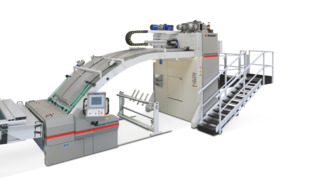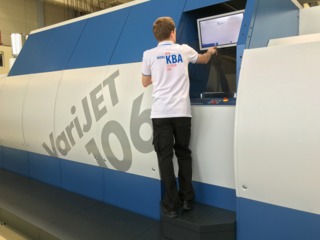Digital Makes Inroads into Folding Carton Market at drupa16
While the folding carton market will experience some growth in the US, worldwide the opportunities look even more promising.

While the folding carton market will experience some growth in the US, worldwide the opportunities look even more promising.
Smithers Pira, in its report The Future of Folding Cartons to 2018, notes that folding cartons are a key product in the global packaging market. Valued at $140,000 million in 2012, the market continues to grow and is forecast to be worth $184,000 million in 2018.
The market’s growth is fueled by the ongoing demand for healthcare and pharmaceutical products, along with dry and frozen foods and cigarettes, primarily in the emerging economies.
While experiencing competition from plastics and other substrates, the U.S. folding carton market is expected to grow .5 percent through 2019, and the total value of US carton shipments should climb to $9.5 billion over the same period, details a report from the Paperboard Packaging Council, Trends: 2015 Industry Outlook and Market Data Report.
And while the demand for folding cartons continues to show strength, since the first of the year, “which is a continuation from last year, there is tremendous demand for quality and more efficient converting machines, which is good news for us,” said Doug Herr, director of sales, folding cartons, Bobst North America. “We see customers spending additional funds to purchase new equipment that is extremely efficient and can produce quality packaging.”
With the US, overarching market trends in the folding carton segment mimic what is happening throughout the greater graphic arts industry: Customers are seeking quicker turnaround, shorter runs, higher quality output, and lower prices.
Efficiencies are driven in every area of folding carton production – for instance by optimizing make-readies and increasing running speeds – and by offering more elements in a one-pass productivity in the finishing area, explained Joerg Daehnhardt, directo of product management, Heidelberg. “Run lengths are more diverse than ever, and with digital print options directed at folding carton production being presented at drupa, the die-cutting area faces new challenges as well. Special effects for higher value or anti-counterfitting are also being sought after; compliance is being enforced by serialization for enhanced traceability.”
While digital production has infiltrated other segments of the packaging industry, within the folding carton segment the technology is primarily used for smaller, targeted runs. But given the need for brands’ to offer packaging that is directed toward specific demographics, as well as to test market its packaging, digital technology is poised to make significant inroads into the folding carton industry.
If you look at announcements and dispays at drupa 16, that trajectory is not in any doubt.
KBA Sheetfed Solutions, a business unit of the Koenig & Bauer Group (KBA), and Xerox announced a partnership to develop an industrial digital sheetfed press for the folding carton market.
The KBA VariJET 106 consists of a KBA Rapida 106 press platform powered by Xerox Impika inkjet technology. The press, in the final stages of development, will print 4,500 B1 (750 x 1060mm/29.5 x 41.7 inch) sheets per hour. Its modular concept enables the combination of digital inkjet printing with optional in-line capabilities such as coating, cold foil application, rotary die-cutting, creasing, and perforating.
The Primefire 106, a joint development between Heidelberg and Fujifilm, is a B1 inkjet press that incorporates Fujifilm’s Samba MEMS printhead technology with Heidelberg’s press manufacturing and system integration expertise. The 7-color (CMYK, orange, green, and violet) inkjet system covers up to 95 percent of the Pantone color space, and its water-based fluids are in compliance with the Swiss Ordiance – mandatory for production of low-migration food packaging. “Designed to withstand the harsh environment in a folding carton operation and based on the XL 106 platform, this machine stands out with its vibrant print quality and high registration accuracy,” said Daehnhardt.
The new machine, the progeny of the 2013 Heidelberg-Fujifilm partnership, will be driven by the Heidelberg Prinect Digital Front End (DFE).
Also introduced was the Anicolor 2 technology for the Speedmaster XL 75, the second generation of the Anicolor inking unit. The Anicolor technology offers short run capabilities with a very attractive cross over to digital printing (about 350 29-inch sheets are the cross over to other 29-inch digital technologies) – while at the same time offering also typical offset efficiencies when pursuing longer runs, as conventional consumables can be used.
Drupa was also the setting for the announcement by Landa Digital Printing and Esko regarding their collaboration to create an end-to-end digital folding carton workflow to drive Nanographic Printing presses. The promise is an automated workflow for order entry through to prepress and the Landa S10 Nanographic Printing Press.
At drupa 16, BOBST introduced the M6 digital flexo web press, the first deploy of the newly christened BOBST Frienze, formerly known as Nuova Gidue. The Italian manufacturer of narrow web machines was purchased by BOBST in May 2015. The M6 is a “machine that we see in the future as the baseline for quick changeover, short run production of folding cartons,” said Herr.
“The M6’s technology, quick changeover, little waste of board, and flexibility of this particular machine is perfect for short and long runs. It can run folding machine stock as well as flexible materials, and offers low costs in ink and maintenance,” Herr said. Cartons produced on the line can then be converted using the BOBST die-cutting and folding & gluing equipment available to most carton makers.
This new machine complements BOBST’s sheetfed equipment very well, he added.
At drupa, the M6 digital flexo in-line UV press with nine-color UV flexo printing and a 670mm web width was running with an automatic de-curler and a final sheeter with high pile delivery.
Digital decorating is also now a very real possibility, with such solutions as the iFoil from MGI and Scodix’s foiling module for its Ultra Pro Digital Press. With the cost of tooling and set up eliminated, brands now have the ability to test market packaging with unique foiling and coatings on their folding cartons. Of course, for large campaigns the most cost effective and efficient method is still conventional foil stamping and coating processes.
To that end, BOBST introduced at drupe the MasterFoil, 106 PR hot-foil stamping press that incorporates Foil Unwinder,+, a system that delivers up to 30% more press productivity and a reduction of up to 50 percent in foil use, said Herr.
“On the finishing side, the trend is more about process integration and including blanking in the die-cutting process for a wider range of converters,” said Daehnhardt.
Heidelberg and its partner Masterworks launched the Powermatrix 106 CSB, a 41” blanker that runs at up to 8,000 sheets per hour – and announced the Promatrix 106 CSB, which will become available within 6 months. The Promatrix 106 CSB is a blanker focused on the independent folding carton market and will make it affordable to many converters for the first time to integrate blanking in a die-cutter, said Daehnhardt.
The two partners also introduced the Diana Eye offline inspection system, which allows each single carton to be checked for print quality, embossing depths, foil/hologram effect, barcode quality, and serial number against a database. Using patented variable light dome technology along with several specialized cameras, the system can read print on metalized board and spot coating effects. The machine is available in two different sizes: a 16.5 inches wide machine and a 20.4-inch-wide machine.
“The ultimate in postpress process integration is offered by the Duopress 106 FCSB: with two platen sections, this machine offers the possibility to foil, emboss, crease, cut, strip, and blank all in one pass. Holograms can be applied as well. The latest generation of the Duopress was introduced at drupe,” he noted.



